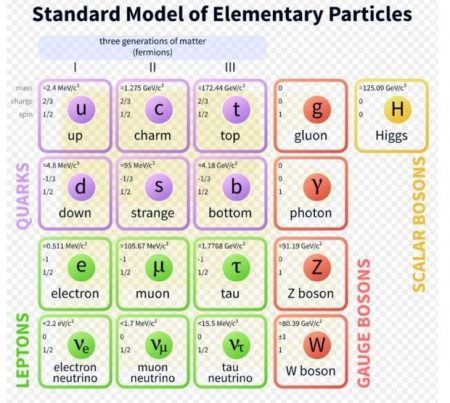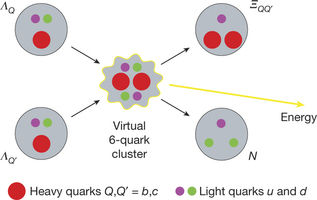November 6, 2017 – In a paper published in the journal Nature on November 1st, two researchers, Marek Karliner, Tel Aviv University, and Jonathan Rosner, University of Chicago, describe the exothermic output of melting two quarks together in a fusion process. It turns out that fusing quarks yields eight to ten times more energy than the fusing of atomic particles, the current standard for experiments with nuclear fusion.
Quarks are the elementary particles that make up matter. There are six in total that go by the following names: “up,” “down,” “charm,” “strange,” “top,” and “bottom.” Every quark has a slight electrical charge. Quarks and other elementary particles form the atomic particles we are more familiar with: protons, neutrons, and electrons.

In normal fusion reaction scientists attempt to fuse two atoms together. But Karliner and Rosner looked at the possibility of fusing at the subatomic level and chose to experiment with “bottom” quarks. When they measured energy output from experiments both were surprised. The yield was so high they became concerned about its potential use as a weapon. That made them hesitate to publish their discovery. But as Karliner points out, fusing quarks is a “one-trick pony” and, for the moment, not a practical energy source.
Why is that?
The experiment and its yields involved the fusing of “bottom” quarks which exist for only one picosecond, one-trillionth of a second. As such the energy reaction happens in one instance, and that means the energy from this type of fusion event cannot impact neighbouring subatomic particles leading to a chain reaction. In other words, a bomb. As Karliner states, “If I thought for a microsecond that this had any military applications, I would not have published it.” For now, therefore, it appears that there is no practical application for what they have discovered.
But could there be in the future?
The atomic age began with fission bombs dropped on Hiroshima and Nagasaki in 1945. Commercial nuclear energy in the form of fission reactors soon followed. Thermonuclear energy derived from a sustained fusion reaction has never yielded a commercial application although several ongoing experiments may one day yield more than a bomb from this technology.
And now we have discovered subatomic fusion in this proof in theory that quarks can be fused together. Other researchers are bound to attempt similar experiments to that done by Karliner and Rosner. Will they solve the “one-trick pony” issue in the hope of creating a new sustainable non-carbon-based energy source for the world?
And will future researchers go beyond matter at the subatomic level, and test fusing of matter and antimatter, searching for the next great energy discovery?
After all, it’s pretty clear that theory tends in time to become something more than just impractical observation.
Meanwhile, the pursuit of commercial fusion energy at the atomic level remains the tantalizing prospect of this 21st century.










